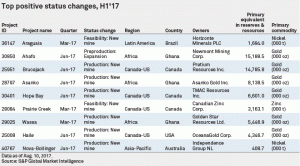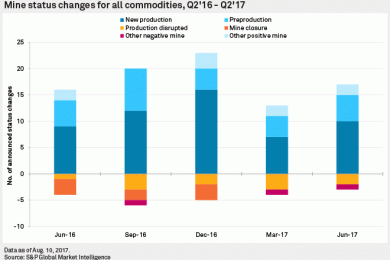Nick Wright of S&P Global Market Intelligence reports that “the number of positive project status changes increased in the June quarter, after a dip in the March quarter, and the number of negative project changes decreased for the third consecutive quarter. The upswing in positive milestones was matched by second-quarter improvement in mining project financings, exploration drill results and initial resource announcements — three other measures of industry health tracked by S&P Global Market Intelligence in its monthly and quarterly Industry Monitor reports.
“Production startups at new mines, expansions and re-openings rose to 10 in the June quarter from six in the previous quarter and were up from seven in the year-ago quarter. The number of mines temporarily halting or significantly reducing production fell to two from three in the previous quarter. Continuing a yearlong positive trend in mine construction and development, five new mines, mine reopenings or expansions began preproduction work. For the second consecutive quarter, no mines were reported to have closed.”
The main diagram shows mine status change for all commodities.
Development mostly focused on gold projects
Primary gold projects accounted for 13 of the 17 positive milestones of all types in the June quarter, including nine of the 10 new production startups (a new nickel mine was the 10th) and four of the five projects entering preproduction for new mines, mine re-openings or expansions; the start of work on reopening Vedanta’s Mount Lyell copper mine in Australia accounted for the fifth. Two gold mines halted or reduced production, and one copper mine, KGHM Polska Miedz SA’s Sierra Gorda operation in Chile, dropped a planned expansion project.
Latin America and Asia-Pacific most active regions
Over the past five quarters, 27 positive and 10 negative status changes were announced for Latin American projects, and 26 positive and 12 negative changes were announced for projects in Asia-Pacific, which includes Australia. Activity in these two regions was much higher than in Africa, which was third in positive changes with 18 — remarkably, Africa had no negative changes reported during the period — and in fourth-place Canada-US, which had 10 positive project milestones and only one negative milestone. Europe, including Russia, had seven positive project changes and one negative.
Canada-US home to most high-value advancing projects
Although there were only seven new mines announced in Canada-US between the June 2016 and June 2017 quarters, the top positive status changes by primary equivalent value in reserves and resources in the first half of 2017 illustrate an important difference between projects, depending on their location. Four of the nine largest projects by value during the period were in North America, which tends to host larger deposits that take a longer time and greater expenditure to bring into production, compared with the generally smaller and easier-to-develop projects found in Australia. The region’s largest positive milestone was the start of production at Pretium Resources’ Brucejack gold mine in Canada.
Africa was next with three of the highest-value projects undergoing major milestones — all at gold mines in Ghana: Newmont Mining’s Ahafo, Asanko Gold’s Asanko and Golden Star Resources’ Wassa. Latin America had one, the largest during the period: the beginning of feasibility studies at Horizonte Minerals’ Araguaia nickel project in Brazil. Asia-Pacific had one project among the top nine by primary equivalent value: the startup of Independence Group’s Nova-Bollinger nickel mine in Australia.

Positive status changes definitions
Production: New mine – A new mine that has completed commissioning and is entering the ramp-up phase of production. Does not include reopenings of closed past-producing mines.
Production: Resumed after disruption – The resumption of normal production levels at an existing mine after a period of interrupted or significantly reduced production.
Production: Mine re-opening – The reopening of a past-producing mine that has undergone new studies and mine planning, has completed commissioning of any new development and is entering the ramp-up phase of new production.
Production: Expansion – A capacity-expansion project, mining and/or processing, at an existing mining operation that has completed commissioning and is entering the ramp-up phase of the expanded production. Includes only expansions representing a net increase over original capacity; i.e., does not include the start of mining at new deposits that only replaces lost production capacity.
Preproduction: New mine – The start of construction activity at a project where a production decision has been made and there are funds to proceed with development work. A production decision only is not sufficient.
Preproduction: Expansion – The start of expansion project development activity at an existing mine where a decision has been made to proceed with the expansion and there are funds available to begin the development work.
Preproduction: Work resumed – The resumption of preproduction work at a new mine or expansion project after a significant period of interrupted development work.
Feasibility: New mine – The start of a bankable feasibility study at a project where reserves and resources are sufficiently understood to warrant the full economic analysis of a potential new mine.
Feasibility: Expansion – The start of a bankable feasibility study for the expansion of capacity at an existing mining operation.
Feasibility: Work resumed – The resumption of feasibility study work for a new mine or expansion after a significant period of interrupted feasibility work.
Negative status change definitions
Mine closure – The owner(s) closes the mine, with no plans to reopen it, after the current mine plan is completed; the mineable reserves are depleted; the mine becomes uneconomic; or mining becomes impossible for political or legal reasons, or due to natural causes such as flooding or geological instability.
Production: Disrupted – Production is interrupted or significantly reduced for a lengthy or indefinite period.
Preproduction: Expansion plans dropped – The owner(s) terminates a planned mine expansion project.
Preproduction: Work on hold – Preproduction work for a new mine or expansion is placed on hold for a significant period of time.
Feasibility: Work on hold – Feasibility study work for a new mine or expansion is placed on hold for a significant period of time.










